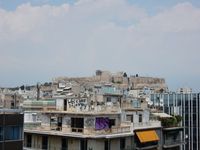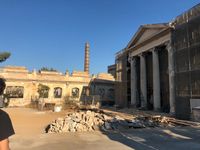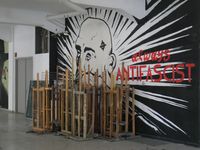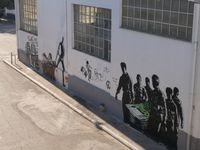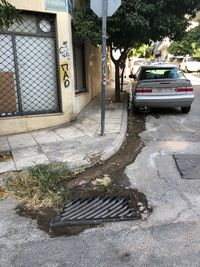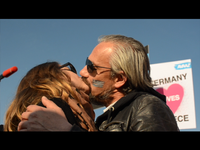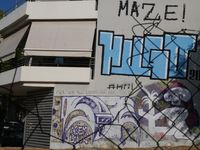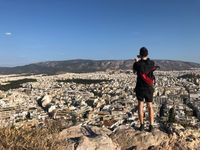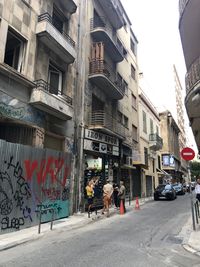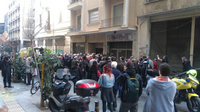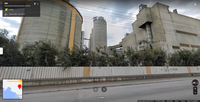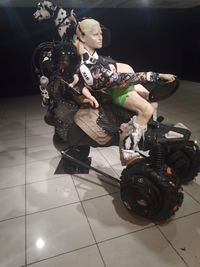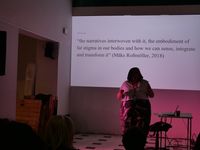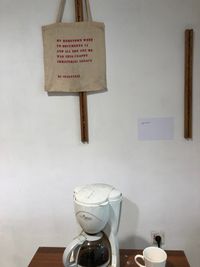We bring you an account of the journeys to the land of ancient ruins we were sent on by an art institution. Our annotated travelogue moves between Athens, the Greek island of Syros, and Ostrava, Czechia. It began by exploring the broad field with the referential concepts of ruin and underground, which are connected by an alliance still a little shrouded in mystery for us. Sometimes with more, sometimes with less anxiety, we learned to rely on intuition, the principle of randomness, but also the ingenious networking of curator Nadja Argyropoulou. Step by step, we have been finding fragments of texts from exhibitions, images of fighting in the streets and in nature, reproductions of dreams of the greatness and the glory of an ancient past that will not come again, of a future that has not yet emerged, and of a present that both unsettles and gives hope. Soon we found ourselves on a boat floating on the gently-spun threads of a company of friends who showed us the way in the multi-layered web of the Greek artistic and activist milieu—an environment that for us, knowing the impossibility of encompassing everything, remains an uncharted sea. On our two-week excursion we had several intense encounters, from which we are spinning this introductory text dedicated to our stop in Athens.
In writing, we use multiple forms (shorter stories, reflections, and references to events or projects) that intertwine, complement or expand one another, suggesting where else to go. If our text is best summed up by the metaphors of exploration and heading to the South, it was not a road we would have trodden first, nor an exploration that no one had undertaken before us. We build on the path already trodden and on the alliances established with the Greek cultural underground in the Trypa project1 and the curator Nadja Argyropoulou, but also on our efforts to grasp the ruination in Ostrava, be it through activism in local neighbourhoods, 2 scholarly research3, or conversations with people—committed artists or activists—who have lived in Ostrava for a long time.
Before the trip
Going to Greece to explore the local (art) underground scene is not possible without considering one’s own positions on what has been known to us as the “underground.” And if we want to discuss the contemporary underground at all, one thing must be made clear: What does the underground (not) mean to us?
We didn’t even use this word before; it seemed useless to us because it seemed dysfunctional. It goes without saying that anyone who is sane and is part of the underground would never say they are part of it. In the Czech context, the term carries with it a number of sedimentary meanings that make a new grasp on it problematic. These are mainly contents related to resistance to the establishment of socialist Czechoslovakia. The underground defined in this way has its historical meaning, but an uncertain presence, because of the change of force fields and prevailing ideological frameworks, to which the underground oriented in this way can hardly react and thus, at certain moments, can pass into unreflective anti-communism (vacuum or timelessness) and historical separateness. This is not to downplay the significance of this underground, but only to ask how useful such an orientation still is in today’s world and whether it can be updated or opened up to new understandings.
The opportunity to reflect on our starting points came right at the beginning of the preparations. Before the trip, we send Nadja a text summarizing our views of the underground in Ostrava. To be concise and clear, we try to avoid schematization and simplification in the text. We come up with our own breakdown of the historical stages of the underground, in which we also include contemporary initiatives and collectives that somehow define themselves against the cultural mainstream and contain at least some political and emancipatory level, i.e. react to the oppressive structures emerging within the current status quo. It’s not historically precise, but it’s enough for us to use as working material. This material then serves as a tool to help Nadja connect us with activists and artists whose work relates in some way to processes of ruination, ruins and alternative scenarios for their reuse, or who are part of struggles for the rights to the city. Finally, we are interested in meeting Teos and Chara, Greek artists and anarchists living today on the island of Syros, who were behind the creation of the Athenian publishing house Octopus Press.
To write about the Greek underground and ruins is also inevitably to reflect on the processes of ruination clustered around the financial crisis that hit Greece with unprecedented force at the end of the first decade of the twenty-first century. It means explicitly defining oneself against the way the Greek crisis was covered in the Czech public discourse4, treating Greece as a country where a corrupt government and people with no sense of measure, lazy, borrowed so much that it became a national debt—hence the label “Greek crisis.” This was not just about the financial crisis, which manifested itself in the austerity measures and the orgy of privatizations under the euphemistically named “European Rescue Programme.” Other crises emerged in parallel, manifesting themselves in the death of the fifteen-year-old Alexandros Grigoropoulos, murdered by the police in 2008, by the increasing repression of alternative spaces in the Athens neighbourhood of Exarchia5, or by the long sheerly unthinkable breaking of the autonomy of universities, on whose grounds the armed forces had until then not been allowed to intervene against protesters6, by the unavailability of housing7, or by the drowning of dozens of people (including children) fleeing war and the appalling conditions in the detention camps for refugees on the Greek islands.8
We both come to Greece from post-industrial Ostrava with our own ideas of what contemporary ruins look like and what “ruin” means in the context of post-socialist Eastern Europe. We have our own experiences with the rise of neoliberalism, deindustrialization, privatization and creeping financialization. We also know what air pollution smells like and what the coal landscape looks like: we have lived most of our lives in it, and absolute distance is not possible (or ultimately wanted). We have our own understanding of the crisis that post-industrial regions are going through. Do we share any of this with a place like Greece and Athens? Are we allowed to ask this? Can we learn something from each other, both having the experience of the crisis?
We are aware that reflection based on a review of our own starting points is a good start, but it cannot prepare us for the many new contexts we will enter during our trip. We ask ourselves how to cultivate sensitivity in approaching the themes of others, avoiding staring, romanticizing and exoticizing. What opportunities will we have to disrupt the emerging asymmetries of power, so often obscured and difficult to discern in the rapid simultaneous movement of events?
Before we leave, we gradually begin to hear from Nadja’s contacts and fix an itinerary of meetings with them. The scope is quite broad, and we don’t know if it will make sense altogether. We rely on chance, on the human ability to read stories, on sudden insights and promptings, and on Nadja’s clairvoyance.
Setting out…
We get up early for the train to Vienna. We exchange a few words on the train about the unclear assignment for the project, the vague expectations (as we don’t know until the last moment today whether we will go somewhere tomorrow), and our curiosity. For some reason—perhaps inertia and the burden of language—the motif of an adventurous journey hangs in the air. We are flying to Athens. A quick change of place, a flyover, and a soul searching for anchors in the new surrounding matter:
A: The journey goes quickly. From the plane you can see the countryside because it is a beautiful sunny day. I see a red lake somewhere in Serbia among quite possibly high mountains, and curiosity glues me to the dingy glass at my window seat. The land lightens and seems dustier, my eyes rest for a moment on the blue of the sea, there is more and more development in the hilly landscape, large estates with turquoise rectangles of pools, smaller houses are added, the estates are not so conspicuous anymore, and then they merge into the completely built-up areas of the city, but no matter how I look I am unable to identify the colours of the big city, everything seems too bright. And already we are landing at the airport, going through Covid and ID checks, the screens welcome us, on the left a multicultural modern European metropolis flashing with a rich history, on the right Greece, the sea, the beaches, the islands. We take the train into downtown Athens, the train gradually becomes a subway and fills up. We change at Syntagma station, under the square of the same name, which has been the scene of much fighting in recent years, and get off at Omonia station, decked out in orange and yellow as if it were a spa. The escalators take us to the edge of Omonia Square. We walk towards the Solomou Hotel, past the road where cars are racing. The cobblestones are dry and covered with a layer of the remnants of the past weeks, as it probably hasn’t rained for a long time. The smell of urine wafts into my nose, my suitcase rattles. The smell is the presence of the other in us, it stands for an encounter.
K: I don’t remember much of the journey. It was fast. The only thing I struggle with is the sudden change of perspective when I see the sea and the sun. The more we are in the South, the more it caricatures where we came from. Ostrava is black, a place in the North, on the border with Poland, true, with a great story of development but a vague present. How to describe it so as not to caricature it, how to grasp it so as not to exoticize it, how to capture where it is now and still be intelligible to the friends we are about to meet? The complexities of post-socialism in Central and Eastern Europe. The ruins of building enthusiasm. We need to tune in, to connect. Language and shared meanings. Our bodies need to sit down. Where to start?
A different Exarchia
With our heads and bodies full of post-arrival tune-ups, we head straight to our hotel in the Exarchia district near Omonia and Exarchion squares, a short walk from the famous National Technical University, which played a major role in the uprising against the military junta9 and is still an important site of resistance against fascist tendencies, police violence and anti-social government actions10, and also close to the ongoing biennale, but somehow out of the way.
There is something reassuring in this old world of anonymous hotels, where you just have to arrive in time for breakfast, pay—and no one asks you anything else. It was a good thing we ended up here, and not in some Airbnb rental inside the sneakily gentrifying centre of Exarchia. It forced us to confront a different Exarchia than the one we had come to see. One where cards are played in the streets, drugs are taken, where stealing and hustling are the order of the day. Streets whose pace is set by the business cycles of dealers and by the traffic lights of a four-lane road full of speeding motorbikes. Pakistani, Afghan and other shops of settled refugee enclaves with newly opened coffee roasters formed the backdrop for our daily journey to appointments in the somewhat more utopian bubble of revolutionary Exarchia.
Dionysos in (post)pandemic times
Resting in the hotel recharges our tired bodies, but more needs to be done to recharge, so we set off on our first excursion around the area. We don’t have a clear destination, and we let ourselves be captivated by what’s coming. The streets begin to fill with black-and-red banners with A’s in a circle, political graffiti and posters with statements from various collectives and initiatives. In a newsstand on Exarchion Square, a conformist-looking man in his fifties sells not only tobacco, newspapers and tabloid magazines, but also zines of local left-wing initiatives. We move on and come across a dilapidated house where an exuberant party is obviously going on. Great, our first contact with a ruin that has a meaningful use. We go inside and discover it’s the opening night of a photography exhibition called Dionysus in ’21. Dionysos was the Greek god of wine, joy, chaos, but also emotion and instinct. And the exhibition similarly maps the phenomena of joy, community, sexual freedom, and hedonism among young artists in the post-lockdown era of the Greek summer of 2021. The photographs mix images of naked bodies, ecstatic states at house parties, portraits of friends pepped up by a certain conspiratorialism, lightness of being, and queer intimacy. The cast of the opening night resembles the people in the photographs. We feel relaxed, with wine in hand, soaking up the vibes of a Saturday night in a legendary neighbourhood. A good start of the journey.
We’ll remember this exhibition several times in our conversations afterwards. For example, when Vassilis Vlastaras, a professor at the Athens School of Fine Arts, talks about encouraging temporary occupations of public spaces or ruins by students as a way to encourage their creativity and ability to express themselves. But then also in conversations with Nadja, the intersection of our paths, for whom one of the representatives of the contemporary underground is, among other things, the Greek queer scene—precisely because of its ability to be an independent world that can (and probably is forced to) create its own chains of production and care (places, clothes, artifacts, music, identities and relationships).
A trip above Athens
The following day we take a trip towards the Hymettos mountain range, which lies southeast of Athens. We need to gain perspective and insight into the city before diving back into its centre.
The slopes we follow reflect the changing historical relationship with the Athenian landscape. Much of the massif still reflects the period of deforestation, when the succession of trees was prevented by periodic burning of the forests. A certain type of ecological approach compatible with the peasant style of life prevailing here until the early twentieth century was thus applied. As the peasant landscape changes with the expansion of the city, the bare hills become a kind of ruin in the eyes of the inhabitants, but one that offers a new opportunity with new needs. Goat herding recedes into the background (or rather into areas where the urban eye cannot see), and the need for rest and escape to a green oasis arises. In 1899, the Philodassiki Enossi Athinon (Athens Friends of the Forest Association) was founded with the aim of reforesting the bare hills in and around Athens. One of them is the area around the Kesariani Monastery, situated on the slopes of the Hymettos massif, where forest paths lead us when we want to reach the historical ruins of early Christian sanctuaries marked on maps. Along the way, we pay tribute to Kaiti Argyropoulou, the former president of this society, who in 1945 initiated the planting of more than three million trees that now provide us with shade on a hot Greek day.
We climb higher—outside the wooded areas to finally get a good view of the city. Anna’s shoes are falling apart as she walks. We laugh that disintegration is part of our trip.
For the first time, the whole of Athens appears clearly before us. The sea and a large valley surrounded by high hills—a perfect place to found a city, if only there were a river in sight. We expect the great glass office buildings that dominate almost every metropolis today. Where are they? We don’t see any office complexes built of excess capital. Athens seems to be dominated only by the Parthenon on the Acropolis. The ruin above all.
On the way down we pass a dog pound, then more strange buildings with unidentifiable functions. Two huge tyres lie beside the road, like the marble blocks of Greek columns leaning against each other in Stanislav Kolíbal’s photos.11 With the first “No Photography” sign, we learn that this is a large military base. We recall the Czech programmers imprisoned in Greece on suspicion of espionage, and discuss the aesthetics of computer games and virtual reality, which often find inspiration in the ambiguous backdrops of abandoned buildings and city edges, where wildness meets an absence of surveillance. The human element recedes into the background. These are motifs we subsequently encounter in the exhibitions of the Athens Biennale.
Going to the sea. We are confronted by beaches with a charge for entry, overcrowding, and an exhibition of vintage motorbikes. We bathe free of charge. Many of us swim. Many refugees from the near and far East are around, two transwomen are sunbathing behind us, and everything forms a strange interplay of worlds. A friend of Nadja’s whom we meet later mentions the beaches around Piraeus as places where Athenians will not go swimming at any cost—the water is dirty and only a bunch of tourists and refugees go there. And so does she—secretly—because she likes the contaminated proximity.
The city is your gallery
The next day, our meetings begin. We plan to visit the Athens School of Fine Arts (Anotati scholi kalon technon) to meet the artist and teacher Vassilis Vlastaras. On the way from the Kallithéa metro station we pass many buildings and complexes resembling suburban agglomerations of warehouses and light industry. From a distance, the front of the art school complex looks a bit like many another ancient ruin, but it is only a slightly ruined neoclassicistic imitation of a temple. Also, what would an ancient monument do here among the factories without a proper parking lot for busloads of tourists and without souvenir shops?
Further on in the complex, there are buildings that evoke industry to a greater extent. These are former textile factories now used by the school. After being checked for infectiousness, we move on through the complex, which bears an interesting contrast of politics, radicalism, craft, but also consumerism. The buildings retain their industrial feel, and the interior spaces are mostly civil, empty, without any pomp, with posters and large graffiti on the walls. Only the cafeteria, with its offer of universal corporate goodies and sodas, looks school-like and a bit consumerist, which contrasts with the politically radical graffiti on the walls and the overall atmosphere of the place, which looks more like a squatted cultural centre than a university.
Vassilis is a nice fifty-something man with a long beard who gives us about an hour of his time before disappearing into the bowels of the school. We learn that the evanescent, the ephemeral, the temporary plays an important role in his approach to life and art in relation to urban space, art and movement.12 It’s hard to say how much his perspective represents the more general attitude of people at the school, but we like that he encourages students to create things outdoors, in the city, to use abandoned spaces or public spaces to express themselves. At the same time, Vassilis tries to avoid putting himself in a position of authority by telling us what is and is not right. He exemplified this approach when he and his students occupied an old disused hospital on the outskirts of Athens during the pandemic, when classes could not be taught inside the school building. The idea was not so much to stay somewhere, as we know from other “occupy” projects, but rather to come somewhere, do something and move on. To try, to express oneself (“try or die,” says Vassilis). According to him, there is no space in the galleries, and if there is, it is very little and very constricted. When we tell him that we have a lot of ruins and abandoned buildings in our city, but mostly well secured, serving more as a repository for the money of various rich people, he urges us to hack these buildings somehow. Later, we try to find out what he meant, but we only come across the urban hacking movement, which usually involves knitting woollen covers for railings, guerrilla reshaping of public spaces to better serve the community, removing homeless barriers on benches, and other small things. But how to hack the Jindřich Hotel, a monumental structure forming a mental hole in the centre of Ostrava, surrounded by a four-metre-high opaque wall and a multitude of cameras? Or the Ostravica department store, covered with concrete on all sides? Do we have a space for the spontaneous creation and experiments that Vassilis is talking about? We are thinking of the testimonies of people from the Ostrava underground, who situate the guerrilla use of abandoned urban spaces and buildings mostly in the 1990s and the beginning of the first decade of the new millennium, when the old system had fallen but the new, economically rational one, which turned the ruins into a controlled asset, had not yet found its way.
During our conversation, pigeons fly into the snack bar through broken windows several times to see if they can dig out any crumbs from our leftovers. It might be also this that motivates us to explore the school afterwards by ourselves. We sneak into various studios, uninvited like pigeons. When we‘re finally caught by a staff member while hanging around students’ works, instead of spreading our wings and taking flight through a broken window, we cowardly mention Vassilis’s name, gaining thereby the privilege of free movement, going into full tourist mode and taking pictures of the radical graffiti and messages on the walls before we sneak away.
First meeting with Nadja—a little closer to looking back at the crisis and defining the underground
In the early evening we go to a very lively part of Exarchia, to a bar that could easily be a cut-out from a book of gentrified spaces with industrial design and a menu that can’t discourage lovers of themed cocktails or filter coffee (they even had Czech Pilsner). There, a crucial conversation with Nadja and her friend, architect and designer Iris Lykourioti, took place thanks to which we “tamed” the place so much that we returned repeatedly to sort our notes.
With Nadja and Iris, the subject of the economic crisis came back into view. According to them, the main consequence of the Greek crisis was the destruction of local production chains (from product design to production), which used to be the foundation of the Greek economy and which also formed the basis of local communities. The logic of (not only) the last crisis was to cut out (in other words, to let go bankrupt) certain segments of these chains and to make the production communities dependent on the supply of large multinationals, as happened for example in the shipbuilding sector, which was originally a traditional Greek manufacturing sector. This has created a much greater dependence on globalized capital, i.e. a situation associated with a high degree of heteronomy, where someone or something outside our control influences our lives according to some other law or norm that fails to serve local needs and local situations. An example of this is the Greek islands in the Aegean Sea, whose inhabitants have come to rely heavily on the excesses of tourism as a source of income, selling land or shifting the entire focus of activity to the tourist service sector. However, during the pandemic they suddenly found that they had nothing left, that already with the first major shock they were unable to respond to the effects of the crisis. A similar process is taking place in many parts of the world, where indigenous communities have unlearned to be self-sufficient, to produce something specific to their locality. It is not necessarily a question of control over production, but of access to basic social or material needs. In our country, there is a housing crisis, which is undoubtedly linked to the massive privatization of public housing and the transfer of huge housing portfolios into the hands of private investors, a process ruining many neighbourhoods in Ostrava.13 In other places, indigenous communities are losing access to water or historical territories linked to their identity. In other words, we are dealing with an unprecedented period of ruination, which Jason Moore provocatively calls the Capitalocene.14
In relation to the cases Nadja and Iris draw our attention to, we subsequently study Simon Murray’s book Performing Ruins.15 In it, he writes that the current interest in ruins reflects a powerful experience of ontological and epistemic uncertainty arising from processes (climate change, economic upheavals and crises, terrorist attacks, and a general global atmosphere of conflict) that confront us with the finitude of modernity. However, as he points out, the ruins that emerge in this process of the end of modernity are not merely a site of mourning or a site of historical reflection, a site in which nothing new emerges. On the contrary, the ruins are far from being nothing or becoming a mere unipolar report of a historical tragedy. The ruins can become a place of subversion, a place that cannot be easily controlled because of its ambiguity, a place that is provocative and unbridled, a place in which the conditions for renewal and a life built on different foundations can emerge from emotional, psychological and even material decay. Ruins can be a place for sabotaging the productivity and inertia of capitalism, as the PLATO gallery project Sand in the Gears proclaimed.16 Ruins can be a place of optimism and hope.
We feel that despite the horrors and crimes of crises, whether Greek or global, this is the message that Nadja and Iris and other people we subsequently meet are trying to convey. That there is a movement from the bottom up that takes the good aspects from the underground but also escapes self-imprisonment in the underground, where it confronts nothing and goes to the surface to cause factions by making the ruins of capitalism a place of subversion. It seeks to recover autonomy, but at the same time it can no longer be fully autonomous, escaping clearly given political categories and reviving a space for experiment and performance instead of prescribed tactics. For the purposes of this further examination, we label it the post-autonomous underground, which can no doubt also be associated with the overall shift in the politics of political subcultures and social movements towards post-autonomy, that is, from self-marginalization and the creation of autonomous oases to interaction with the madness all around us.
We get a lot of references to projects, initiatives and actions that illustrate this post-autonomous underground. Some of the contacts then become the basis for our next meetings or studies. It is no coincidence that some of these projects appear also in Murray’s research, as he is looking for performative associations across various European cities and their ruins. His occupations of abandoned or semi-ruined sites and buildings, and the protests around them, similarly caught our attention here. All of the protests responded in some way to the political climate of recent years, but they also contained a certain degree of utopia, openness and defiance of clear categorization, including the category of the underground that we cast upon them and which seems to us to be close to and typical of the subversive potential of ruins.
What we take away from our conversation with Nadja and Iris is the idea that the post-autonomous underground, if we can even call it that, is oriented around three principles. It is capable of reclaiming autonomy to some extent through the collaborative re-creation of local chains of production (examples include local agriculture, local energetic17 or artistic communities, and shared housing projects), while at the same time somehow using what capitalism has left behind as ruins to gain autonomy. Last but not least, it does not close itself but creates factions and fissures in what could be considered mainstream or status quo.
One such project to which we are referred and which also had an artistic overlap is the Kassandras project initiated by the designer and architect Mathieu Pratt.18 Mathieu and others rented a dilapidated, unfinished building in the Tavros district of Athens and began employing local artists and craftsmen affected by the economic crisis. They created a supportive environment for the development, prototyping and actual production of various site-specific architectural and design constructions, while using them as a tool to revitalize the ruins in which they emerged, drawing the users of architecture back into the process of its creation.
Another example embodying the principles of the post-autonomous underground is the art association Mavili movement, which has had two major occupations (of the Empros Theatre and the Green Park Café), what they call “reactivations” of spaces that have subsequently served as sites of performances, art, but also political imagination, encounters and solidarity projects. This second example of the underground associated with ruins subsequently became the subject of our further research and discussions with Kostas and Vassilis, two artists from Mavili whom we met later.
After speaking with Nadja and Iris, we begin to see common denominators to build on. On the one hand, we are getting a new take on the underground that communicates more with today’s times. But we are also turning our attention more to the mechanisms of crisis, processes of ruination and ruins-in-reverse, in which, in contrast to Robert Smithson’s original concept, we place glitzy generic office buildings, shopping malls in city centres, whose externalities are the ruins of our communities and the abilities of neighbourhood autonomy. Our attention shifts from the ruins themselves to that which ruins.
We leave with the hope that things are beginning to fall into place. But there is still so much more to write about.
How do the Athenians cope with this?
In between conversations and meetings, we are increasingly confronted with the inhospitality of the city and our neighbourhood. Heavy traffic and drivers who don’t like to be held up by traffic lights. Motorcycle owners taking advantage of the absence of cars on the sidewalk and zigzagging through the clogged streets between pedestrians (or is it rather pedestrians zigzagging between motorcycles?) We notice how the city silences and separates us. It is impossible to walk side by side and talk; it is impossible to walk behind each other and talk in raised voices. It exhausts you immediately, it sucks your appetite out of you, it silences you, it shuts you down, you can’t stand the noise. How do the Athenians cope with this?
But we have more humorous experiences as we make our way through the city. Sometimes a little trickle of water runs down the street. And in some places there’s more water flowing.19 It might happen that while waiting at traffic lights, something drips down our necks. Thus we discover the ubiquitous air conditioning as a basic adaptive mechanism of being in the city and its imperfect condensate drainage system. Anna recalls the mysterious film Air Conditioner by Mario Bastos with falling air conditioners in the main role. We laugh at the thought that soon they will start falling here too.
The journey slowly begins to take on a regular rhythm, combining forays from the Solomou Hotel to fixed appointments, then somewhere to eat and retreating back. To process an increasingly complex set of stimuli and information requires a respite and concentration that is lacking in the bustling city. We look forward to visiting Teos and Chara on the island, but at the same time it’s hard to break away from the gravitational pull of the capital. After all, there is so much left to see and visit.
Evi and Panos: What will we learn from us?
In the Petralona neighbourhood on the outskirts of Athens, we meet Evi Giannakopoulou20 and Panos Sklavenitis, artists and teachers whose work and approaches continue to accompany us in internal dialogues even after our return to Ostrava. We are sitting in a restaurant that is already full at eleven in the morning. We outline the initial situation of the city with its industrial past and the many ruins from which we have come, and say that we are looking for alternative scenarios for our ruins. Perhaps for the first time we get questions exploring our ruin in more detail; for the first time someone is interested in what we are actually up to. Until now, we’ve followed the themes of our conversation partners—and this was suddenly, in a way, surprisingly difficult. Although we did not have a clearly defined research question, and what connected us to the people we met were Nadja’s friendship networks, an important moment inherent in ethnographic fieldwork emerges (being in place is ultimately shared by both tourist and ethnographer)21. It was a moment in which we came to confront an ethical dimension of our trip that we may not have been able to think through sufficiently until then. Who are we, and what do we want here? Is our crisis sending us to you? Without wanting to, are we driven by ego and self-interest? Do we want to gain new perspectives to take a fresh and better look at our situation, or do we want to care about the environment, needs and interests of the people, places and ecosystems we are now in? Why are we actually here, and for whom? This is a question that needs to be asked repeatedly, because it refers to the problem of romanticization, exoticization and aestheticization of the crisis that has invisibly crystallized in our country. Was it the pitfall of an anthropological or, if you like, sociological perspective? It is never useless to repeat to oneself: Theoretical references are good, but they mean nothing without self-reflexivity. We have to mobilize our listening skills and our mindfulness, because we are confronted with something we do not know. Understanding this situation is not so easy, and it doesn’t happen in the blink of an eye. Our answers to his questions are quite confusing, but Panos is a tireless questioner and he really wants to know what we are up to. He is a terse speaker, but what he says is apt (and at the same time humorous). Both Evi’s and Panos’s approach to our topic is politely critical, which proves to be beneficial. Gradually it becomes clear why we are all sitting here. Evi has a lot of interesting ideas which, it soon turns out, will become important and move us forward. The first example is the work of documenta 14 in Athens, and the second is Elefsina, some twenty kilometres from Athens, which is to become the European City of Culture for 2023 and has based its candidacy on the coexistence of ancient and industrial ruins. Two days later we make a trip there.
Documenta, in Kassel, Germany, is an institution exhibiting modern art.22 Sometime in 2016, the organizers of documenta 14 came to Athens to meet the art community under the title Learning from Athens and literally “learn from a city in crisis.” Ideologically, documenta 14 refers to “that part of Europe that seems to be a prime example of the often extremely violent contradictions, fears and fragile hopes” that could just as easily take place in “any other precarious contemporary democracy” and “makes Athens probably the most productive place from which it is possible to think and learn about the future to come,” as Adam Szymczyk, documenta 14 director, points out.
Ever since the crisis, processes of exotification of the Athenian scene have been advancing, and the Greek metropolis has been becoming a “hub for art.” The title of documenta 14 raised a question in the minds of the locals: What can we learn from us? What can be learned from a city or a country in crisis, whose cultural institutions are affected by a policy of cuts and whose private support for the arts can be counted on the fingers of one hand? What does it all mean, who will be able to participate and who will be the one to learn? Shortly thereafter, a research group fairly named Learning from documenta is formed from researchers from various social science and arts disciplines (including Evi).23
Documenta 14 comes at a time when Greece is losing political sovereignty to the globalized financial market and moving towards a policy of austerity. Yet Athens still remains an attractive place for foreign artists who move to the city because they find it an interesting and inspiring place;24 it is the new Berlin. And German banks continue to lend money to the bankrupt Greek public sector at exorbitant interest rates. It is a time of devastating reforms, fear, uncertainty, loss of independence, and humiliation. 25 The arrival of documenta 14 cannot be understood without a factual knowledge of the context, the structure of the feeling of the political situation of that time. Is the situation of crisis really similar in any other contemporary Western democracy? Who has something to learn here, and from whom? Documenta 14 refers to transnationalism, it claims allegiance to postcolonial studies and criticizes neoliberalism, but fails to reflect on its own power position. Documenta 14 in Athens thus becomes, more than anything else, a traumatic event for local artists and curators.
When the interview is over, we still go to lunch together, or rather we are invited to a pay-as-you-go Greek-style lunch, as Nadja later called it when we tried to imitate it at our last dinner. The Greek style means that, for example, on the pretext that you have to go to the bathroom, you pay long before you finish eating and drinking, so that someone doesn’t beat you to the bill. We grew very fond of Evi and Panos, their hospitality and their lucid critical approach to the world.
The Acropolis as a projection screen
After lunch, we walked over the hill where Philopappos’s tomb is located, towards the centre. On the way we passed groups of tourists. We climbed to the top and explored Athens from above once more. The hill from which the Parthenon was fired upon in the past, which during the Ottoman Empire still had a roof and was used as a powder magazine and mosque, now offers, according to tourist guides, one of the best views of the Acropolis. Even today, the urge to shoot down the “deliberately crooked image enthroned on its rock” does not pass.
Slowly we descend into the city. The Acropolis26, which for centuries has been part of new discourses of power, constantly comes into our field of vision as if it were watching over us. A diachronic view on it allows us to enter a new level of meanings. So let us briefly discuss how views of the Acropolis have converged and evolved.
With the demise of the ancient state, the Acropolis lost its function of a visible symbol of power and was used as a foundation on which new discourses of power have been based for centuries, and a container of different contents. New dominions set out their own buildings and hung their own images. Until it was shelled and became a ruin, its physical form and ideology were inseparable. With the Renaissance, the view of the Acropolis turned to the ancient past and became a projection screen of the imagination. By the second half of the eighteenth century at the latest, the desire to return to the original layer began to manifest itself, and the Acropolis became a paradigm, regulated (by a model of something) and regulating (being a model for something), an image between the past and the already present future—in short, a model of the West, influenced by ancient Greece.
After 1834, restoration work was carried out on the Parthenon by German architects and archaeologists, ordered by King Otto I of Greece, son of the Bavarian monarch Ludwig I, to show the world, after “centuries of barbarism,” the remnants of ancient greatness and the ideological basis of the future. The Parthenon became a symbol of political renewal, the formulation of Greek national identity and collective memory.
It is probably no surprise today that the artistic response to the monstrous spectre of the Acropolis in the twentieth century worked with scenarios of explosives being dropped on it or planes crashing into its centre, or recommended a “slow death” by preserving the laws of nature. As we can read in Trypa, “The Acropolis must submit to a biological process, and its natural end will be the breeding ground for the sprouts of something new.”27 Although many years have passed, this sentence is probably still too revolutionary.
Contemporary Athenian artists have an understandably ambivalent relationship with the Acropolis and the ancient ruins. Austerity policies have also affected spending on culture and the arts. Nevertheless, we learn from friends that even before, contemporary art in Greece did not enjoy state support. The Acropolis is, moreover, a symbol of the ruins of antiquity, destroying the resources for contemporary creation. “Do you think the Acropolis has hurt Greece? Everything turns around the Acropolis, we will never create anything new!”28
After conversations with Nadja, Iris, Panos and Evi, we start to understand ancient ruins also as ruins-in-reverse or ruins-makers. In the end, it doesn’t matter if that bundle of money and care is swallowed up by some towering glass skyscraper or the Parthenon on the Acropolis to stop its ruination. The resources, and often our attention, simply disappear in them. While the ruination of places that are not so fortunate goes on. Why preserve the Acropolis and prevent nature from contributing to history, why repair the partly burnt Notre-Dame when we could…
We walk through a neighbourhood where we see the Acropolis on easels and in shop windows as a postcard motif. The Acropolis retreats behind its own iconicity, and its physical reality dissolves into ideologization. Words, language and content scream at us, but who has uttered them? It is a derealization affecting us in a clash with simulacra, contents more real than reality.29
We walk past the modern Acropolis Museum building, crossing perhaps a six-lane road (during the long wait at the crossing, a tourist on a scooter tells us, smiling, that he owns the same backpack), and head towards the Temple of Olympian Zeus in the naive belief that we might get a closer look at it. But in the end we just take a photo of it with a fence and feel a big urge to disappear—also because we are irritated by the aesthetics of the neoclassical Zappeion with its yellow and white plaster and the perfect regularity of the greenery in the National Garden.
“Let us turn aside here and go along the Ilissus; then we can sit down quietly wherever we please,” Socrates says in Plato’s Phaedrus.30 Just beyond the Temple of Zeus lies one of the few stretches of the Ilissus that sees the light of day. The Ilissus is a “lost” ancient river rising on the slopes of the Hymettos massif, buried by twentieth-century notions of progress. In recent years, it came back into the spotlight when trams stopped running in October 2019 due to the outdated infrastructure of the city. Today, the city is considering allowing part of the stream to flow in the open again, giving the residents of Athens back their lost river.31
Hands off our homes, and the political function of ancient ruins
Our meeting the following afternoon with architect Tonia Kateriniti, a member of the Coalition for the Right to the City and the Right to Housing,32 further illustrates the picture of the neoliberalization of the Greek economy as a ruinous process. Tonia is part of a collective fighting evictions, and as an architect and activist she gives us evidence of the creeping onset of the housing crisis in Greece. Currently, more than 150,000 families are at risk of losing their housing every day through bank auctions, while at the same time the number of empty apartments (more than 200,000), which serve mostly as a repository of money, is growing. According to Tonia, these well-maintained ruins are very well protected by Greek laws, so they cannot be used, for example, as social housing. In her story, the influence of financial actors, banks, foreign investors, but also various instruments such as soft loans and mortgages, on the process of the loss of autonomy of local communities, which we discussed the previous day also with Nadja and Iris, emerges perhaps even more clearly.
In the past, Greeks saved for housing or rented. From a certain point, especially in the 1990s, due to the availability of financial products, prices started to rise and loans became a necessity. When the financial crisis hit and people lost the ability to repay their loans, banks started to resell their properties in so-called auctions. Parallel to this, successive governments gradually cut people’s right to stay in their homes even when they were unable to repay their financial obligations, until they cut it out completely. Together with facilitating access for foreign investors, this opened the way for the phenomenon of auctioning foreclosed homes. The packages of anti-debt measures enforced by foreign institutions have also included support for foreign investors, including golden visa investment programmes which incentivize wealthy investors to buy properties that cost more than €250,000 in selected countries by offering them at the same time the opportunity to obtain permanent residence or citizenship immediately. These financial incentives have resulted in a huge influx of speculative capital from various countries, which we are subsequently seeing in the Greek islands, where wealthy investors are buying up land in large numbers. This creeping process is sometimes referred to as the financialization of housing and illustrates a situation described more fully by Raquel Rolnik in Urban Warfare33 and by David Madden and Peter Marcuse in In Defense of Housing34. Perhaps we are encountering something here that affects all of us, that we in Ostrava can connect with and stand in solidarity with. And again, it is not so much about the ruins as it is about what is ruining.
We ask Tonia what their reaction to this situation is. The key is to link the situations of individual families. The psychological effect of losing the ability to repay is shame and guilt. The crisis of capitalism has its external manifestations (housing unaffordability), but also psychological manifestations, where, along with the economic crisis, many are affected by the loss of self-esteem and the feeling that they themselves are collapsing along with the collapse of the system. This manifests itself in the way that they do not want to talk about the fact that they can no longer afford their housing; they want to hide their situation. So the key is to create a safe space for these people where they can find support and see that it is not just their problem, that their stories have a common denominator. In other words, to collectivize emotions that have a public and political dimension. However, the number of meeting places for such groups in Exarchia has been steadily decreasing in recent years due to the repressive state intervention. In these spaces, people who are losing their housing have the opportunity to meet with others affected by the housing crisis, such as residents of certain neighbourhoods from which they are being pushed out by the proliferation of Airbnb, and to plan joint events. They use two strategies. The first is to try to prevent the auction in the auction rooms where the apartments or houses are auctioned, by non-violent actions—by making noise, blocking the entrance, etc.
The second strategy is to put enough pressure on the banks through media events, demonstrations and negotiations with politicians, to negotiate terms with local residents that allow them to stay. The people around Tonia, by the way, have used the historical ruins to do this by posting on the Acropolis a banner in support of the “Hands off our homes” initiative calling for a halt to the auctions. The ruins of the Acropolis thus serve as an amplifier of attention to the ruination that is taking place right now, but which is being denied attention. Even tourist ruins can thus become sites of social struggle, not only historical admiration.
Two days later, we try to attend a meeting of the initiative, but get stuck in Elefsina.
Eleusinian Mysteries
We go to Elefsina expecting a spectacular show of ancient and modern ruins, which was probably triggered by the information about its successful candidacy for European Capital of Culture for 2023; in fact, we still remember the unsuccessful candidacy of Ostrava for 2015. On the way from the final metro station, we stop for refreshments at the bus stop before our bus leaves. We end up spending about half an hour there, because the bus first goes too early, then too late (and we are absorbed in reading), then doesn’t go at all, so we get on the fourth one.
From the bus windows we look through clouds of light dust at a lot of factories and industrial structures. We pass a Hellenic oil refinery, which, we later discover, continues on the other side of the bay. We also pass a plant that processes most of the waste coming from western Attica, and the first steelworks in Greece, which supplied steel for the construction of the National Gallery and the Museum of Modern Art. We are overwhelmed by the massiveness of the cement factories dominating their surroundings and casting shadows, even though it is midday. Industry is by no means a thing of the past here. There’s a paper mill, a factory that produces waterproof industrial materials, somewhere they make buses, and there’s even an army air base. Simon Murray notes in Performing Ruins that there are thousands of such Elefsinas, variations on the profile this city offers. For our Ostrava views, however, it does offer excitement, for the familiar industrial atmosphere is adjacent to palm trees and the sea! And isn’t it these small differences in an otherwise familiar situation that resonate the most?
After a spectacular display of huge factories outside the bus windows, we get off the bus. Walking is not always sufficient for these industrial dimensions. We immediately dive into an empty taverna and, following the example of Evi and Panos, order a tsipouro liquor as an aperitif for lunch. We get a portion so large that we generously share it with local cats.
After lunch we set off to explore Elefsina. We walk along the shoreline with shipwrecks, looking into the distance at the oil refinery on the other side of the harbour. A not-so-conspicuous banner referring to the European Capital of Culture hangs on the concrete wall that encloses the ruins of an industrial monument, a former olive oil factory. We wander lonely through the complex, which hosts performances, theatre shows, and regularly also the Aeschylia festival. We don’t know what more to add—it is basically a ruin in an advanced state of decay. It was silent and empty when we arrived. Is this the Eleusinian industrial heritage? The architecture wasn’t very interesting, but let someone more experienced correct us. With a sigh addressed to Ostrava’s Vítkovice, we hold back a tear and move on.
We walk through the streets of family houses and get bored. It all gives the impression of a provincial town where a dog just died and a cat ate it. So we go to see an ancient ruin, the site of the famous Eleusinian mysteries with the temple of the goddess Demeter. The Eleusinian mysteries, secret religious rituals, were held in ancient times every year in honour of the goddess of the harvest, Demeter. They played out the mythical story in three phases: the disappearance of her daughter Persephone, taken to the underworld by Hades, Demeter’s desperate search for Persephone, and their reunion. As it happens in such places, the title and the description of the monument seem more interesting than the reality. It looks more like an aggregates shop, only there are no customers. We are the only visitors, and we are being watched by a guard who stays far away but never takes his eyes off us. It’s quiet and empty. Elefsina is the only ancient ruin preserved as a national heritage site we visited during our time in Greece.
Athens Biennale—a celebration in the ruins of the human world
During our days in Athens, we visit the biennale. Onassis Culture, one of the organizations35 behind it, usually takes the opportunity to install its activities in abandoned buildings ruined by the financial crisis. However, the life of these buildings does not usually fit into the ruts of gentrification, because, as we often hear, nobody cares about art. Maybe it is semi-gentrification. Evi and Panos reveal that if gentrification is to succeed, it is because of the cafés, bars and restaurants, not because of the art. Factors such as the drug scene, prostitution and exclusion probably play a role.
The Athens Biennale in 2021 is in large part taking place in the Fokas shopping centre building. It is huge, so we need more days with breaks to see it. The theme is mirrored in the eclipse.
“The experience of the eclipse functions as a catalyst for reprocessing an unresolved past that can inform an unspoken present and ultimately shape our future. Thus, Athens serves as the appropriate vantage point for contemplating the nuances of time and space. Furthermore, examining the question is the west in decline or in a moment of significant transformation? Defying the prevalent politics of historical narratives, ECLIPSE proposes to challenge oppressive mechanisms and outdated idealism. By deploying various immersive techniques such as real game play, radical gossip, persuasive realities, “emotional hypnosis,” bodying, synthesis, and visualization, ECLIPSE activates narrative fabrication and orchestrates an experiential shift in art viewing opening an alternative future for contemplation.”36
We will only briefly mention two things that fit in thematically.
It is often said that it is impossible to imagine the end of capitalism, that it is easier to imagine the end of the world. Over time, this has become increasingly misleading, because we are actually imagining the end of capitalism, which does not mean the end of the world. There is no lack of imagination. To declare that the end of man—and with it the end of capitalism—would mean the end of the world is typically anthropocentric. After all, the world will not end until a very long time from now, when all the chemical elements have been transformed into a more unstable isotope of iron; in the meantime, there will surely still be a lot going on in the universe.37
The ritual by the Athens-born Theo Triantafylidis is one such imaginative exercise about the posthuman world, an environment between physical and virtual reality set in a forgotten city with an extractive past, where crows ride electric scooters, ants seize a pack of M&M’s and march happily in a wheelbarrow, hyenas play an aggressive dance set in a car wreck and bark to the beat, in short, smoke. It’s a three-channel live simulation with two braided rugs hanging on the walls. Each subject in the simulation is controlled by a simple artificial intelligence and interacts with the environment to create different situations. Who knows, maybe in a little while a new capitalism will emerge in the human ruins. But maybe not. It’s a really good experience.
In the former courthouse opposite the Fokas Centre we visit Zuzanna Czebatul’s installation The Singing Dunes—Their New Power38, which refers to the excavation of the backdrop of an ancient Egyptian city for the (silent) Hollywood film The Ten Commandments (1923), one of the highest-grossing films of all time. Since the sets of the entire city, with its statues of Ramses II, huge plaster sphinxes and an Egyptian temple, could not be moved anywhere and disposed of, and the film was well over budget, the director Cecil B. DeMille and his team decided to deliberately tear everything down and disappear. These ruins were not discovered by archaeologists until nearly a century later.
What we discover here is an unexplored ruin of fiction that is arguably something more than a mere ruin of capital, and something less than a historical ruin: two understandable forms that we usually encounter and for which we have clear labels.
Vassilis and Kostas: the foundations of artistic occupation and post-autonomous practice
On our last day before leaving Athens for Syros to visit Chara and Teos, we visit Vassilis and Kostas from Mavili at their gallery Eight39, not far from the National Technical University. The gallery is on the ground floor of a house on one of the few streets closed to cars, which creates a nice neighbourhood atmosphere for our conversation. We sit by the open door, drink coffee, and smoke. Vassilis and Kostas share with us their experiences with three cases. The first is ReMap, an art festival that is an example of a vulgar but only partially successful gentrification. The other two examples refer to the activities of the Mavili movement: the reactivation of the abandoned spaces of Embros and Green Park.
It is not news that artists often play a more or less conscious role in the gentrification of neighbourhoods that otherwise shelter the poor, the excluded, vagrants, the trans. There are a hundred and one studies in which art projects foreshadow the gradual transformation of neighbourhoods toward higher-income groups. This was similarly the case in the neighbourhoods of Metaxourgio and Kerameikos, historically inhabited by refugees first from the Balkans and later from the Middle East. A large part of the area we will visit on the last day of our journey through Greece has been bought by two investment companies, and, in parallel with the first Athens Biennale, the companies organized the ReMap festival, which took place in several empty buildings. The artists who were invited to the festival in 2007 had no idea that they were becoming part of a deliberate increase in the market value of the buildings—that the whole festival was part of a businessman’s gentrification scheme. Eleni Tzirtzilaki then published an open letter in which she and several other people publicly exposed this scheme. In her letter, which was on display at Gallery Eight at the time of our visit, she describes how investment companies had evicted refugees from their homes just before the artists arrived so that the festival could take place in a “clean” environment, and had begun to offer the abandoned buildings to prospective buyers. Unfortunately, the financial crisis hit shortly after, so they repeated the festival several more times because sales were not going so well. On the Facebook page of the organizing company, they also graced it with a lofty description: “ReMap has become a world-renowned event for its urban, participatory, collaborative and exploratory spirit.” 2017 was the last time it was held. In the meantime, several sequels have taken place, which the anthropologist Dimitris Dalakoglou reflects on in his article “Remap(ping) Athens.”40 He describes a brief situation that took place during one of them:
“In front of a huge, beautiful un-renovated neoclassic house, hosting the commerce of a gallery, a bunch of well-dressed people spoke in English: they have just met, kissing, laughing and shouting loudly as they enter the exhibition happily. Quite literally five metres away, directly across the street, two men (invisible, it seems, to the happy company) had squatted on the pavement, searching for a vein in their arms to shoot. On the block diagonally across the neoclassical temporary art gallery lies a dusty closed-down hotel; on the same block there is a line of prostitution houses with the red or white lights above their door turned on. A young art student who volunteers for the exhibition tells me, sitting on a wooden bench on the hall of the neoclassical building, “We are all trying to help for the upgrade and cleaning of the area.” This is tricky, from the chat it is gathered that she does not support Golden Dawn, however one year earlier “Cleaning the filth” was the central pre-electoral slogan of the Greek neo-Nazi party. The questions come immediately in the mind: who or what is the filth that needs to be cleaned according to her view? And how they are planning to do that?”
A different example of the artistic and political grasp of the ruins was the Embros Theatre and the Green Park Café, behind which stood the aforementioned Mavili. From what Vassilis and Kostas told us, we can see that these projects connect several levels of what we have gradually alluded to in our previous talks: art, politics, a response to the crisis, (post)autonomy, and at the same time the impossibility of easily classifying and categorizing them. Vassilis and Kostas talk to us mostly about Green Park, but this cannot be separated from their previous experience, the even more famous Embros. We come across the story of the occupied theatre, which has been repeatedly cleared out by the state, both in their gallery and in the book Performing Ruins. In it, Simon Murray reports that on 11 November 2011, members of the movement “reactivated” the Embros Theatre, which was originally a printing press that had become a private but subsidized theatre in the 1980s (which closed in 2005, in part because of decreasing donations; the state then stopped contributing to small theatres altogether in 2011). Mavili occupied the theatre and made it a public space for debates, performances and mutual inspiration. In its manifesto, it claimed to reactivate the disused historic building in the centre of Athens in response to the stagnation of thinking in the society. They invited artists, theatre folks and performers to showcase their art, and along with them, theoreticians and the public to meet and test models of mutual functioning that transcend the limits of existing practice and the structural limits of the market with “artistic production.” The aim was also to change the meaning of the role of art in society. The Embros was a place where people and groups who “flowed” through the building could endlessly debate and replay the reactions that art can assume to crisis. Vassilis Noulas, one of the original members of the Mavili movement, said: “We want to present another paradigm of occupation, an artistic occupation…. One that is more open.”41 In the book Performing Ruins, Mavili members state: “We were constantly faced with questions from the outside: Who are you, are you squatters? Are you doing the post-political thing? Eventually we learned not to answer such questions and not to feel guilty about not knowing the answers. It’s like an art project. You think you know what to do, but in reality you just have a method of dealing with problems.” In the case of Embros, it was important that they prioritized performance over theatre. It was, after all, a response to the political and economic crisis in Greece, and performance naturally evolved into other actions such as cooking, dining, dancing, or political and theoretical analysis—as a completely unproblematic form of combining different activities, as a shared practice, as a form of coexistence and friendship in times of crisis. Mavili was thus able to engage in different activities and explore the relationship between performance, institutions, and the buildings of those institutions. Embros was cleared and covered with concrete in 2015, but it developed such a strong network and community over the course of its operation that it has been reoccupied and continues to host programmes.
Vassilis and Kostas share the Green Park experience with us. It all started with a ten-day occupation of an abandoned café in a park in the centre of Athens. The occupation began on 19 June 2015, coincidentally hitting the deadline for a referendum in which Greeks rejected EU economic conditions (and were subsequently forced to accept them anyway). Thus, like Embros at the time of the Syntagma Square protests, the reactivation of Green Park took place at a politically very important time. Vassilis and Kostas refer to this second experiment as more inclusive than Embros. It did not prescribe a clear ideology or political doctrine in advance, but rather just set out the basic boundaries within which experimentation was possible (they mention mainly the absence of violence, hatred and commerce). The principles of Green Park were friendship and joy. This event was not created by a dedicated activist collective, but on the basis of informal discussions with friends, as well as on the basis of the experience gathered in previous projects, especially Embros. It was a space for experimentation, a space built on relationships rather than structures. Both say that they arrived at the “simplicity” of the Green Park space concept through experience and age. Green Park, for example, hosted the No Future Biennial (23 June – 4 July 2016), which was ambitious not only in showing what role performance could play in the “reactivation” of buildings and abandoned sites, but also in reflecting on the concept of the biennial itself, which they sought to subvert into a self-organized practice, that is, a non-hierarchical curatorship and raising of political, social and cultural issues by the participants in the event. After seven days, the biennial in Green Park ended and the participants took a boat to the island of Kythéra.
Vassilis and Kostas also describe how the Green Park project ended. Until the summer of 2017, they had the tacit support of the local government, led by the left-wing Syriza party (Embros caused much more conflict with the local government). After that support ended, there was a period of increasing police repression, which was linked to a general shift in access to free spaces. In the case of Green Park, this meant that the police were pushing street drug users and refugees off the streets and into the park, where there were already enough of them, thus putting pressure on Green Park’s capacity to develop solidarity activities, and subsequently cutting off their electricity. So at some point Mavili decided to leave the premises. Finally, they organized an event called Closing times: Where are we now?, to which they invited the philosopher Jacques Rancière. The event was marked by the municipality’s turning off the electricity, but it was eventually held by candlelight, which Rancière said moved him. It seemed to be a revenge of the authorities, along with the official festivals and exhibitions, who all had a problem with Green Park because of its subversive adoption of biennial concepts, pulling people out of official events for underground lectures in liberated spaces and other activities that formed their political counterweight.
The narratives of Mavili members can be used to illustrate how contradictory art can work in times of crisis. On the one hand, as a gentrifying, unreflective practice, where artists unconsciously but then consciously serve as a tool to increase the value of buildings for developers and as an accelerator for the eviction of the poor and the “unwanted” from the site. On the other hand, art can also serve as a basis for various activities that react to the economic crisis, while creating an alternative and pushing the space of political imagination beyond clear political categories.
Conclusion: post-autonomous underground and cooperation with ruins
After several intensive meetings, discussions and introductions to local contexts, we see the intersection of different stories in the field of ruin and underground as reference points. They are formed around processes of ruination and the refilling of the term “underground.” Slightly burdened by its ossified form, we are on our way out.
In the first case, we arrive at two labels that sometimes merge and sometimes diverge in conversations, and which we then like to use: ruins-in-reverse42 and ruin-makers.43 Our attention is not too focused on the ruins themselves. It doesn’t take long to look at the ruins. Much more can be heard in the voices talking about forces and force fields, about the processes of ruination and about who or what is ruining. It is the sequence of events and convolutions of different processes that play a larger role in the stories we hear. It is not so much about the financial crisis as it is about capitalist relations and global asymmetries in general.
However, in the context of crisis as ruination, we would also like to state that it makes no sense to say that your crisis is our crisis (and vice versa). No comparisons are to be expected: the crisis is not a question of degree and cannot be scaled. Such a perspective would again contain the trap of progress. We may be fighting the same opponent in different places and at different times, and we probably share some of the same problems. Although many of us are driven by the winds of the current post-industrial boom to similar feelings of ruination, and although we are dealing with forces of global scale and transnational character, the heterogeneity of forces and responses is important, for we are not dealing with a single ruined landscape, as if perhaps it were a single field to be ploughed. To write a history of ruin (and the underground), we must follow the fragments of many different narratives and move inside and outside the worlds of their emergence.
In the case of the underground, we were confronted with associations related to a certain type of geography. The underground originally referred to what is “down, “under.” Heaven above and hell below; on a map, north above and south below; the mainstream is the majority and the underground is the minority. Underground and otherness are therefore close to each other by association. The underground can be perceived in relation to this associative space of “below” in which the “others” appear: the weak, the underdeveloped, the poor, the irrational, the oppressed, the mentally ill, the workers, the Gastarbeiter, the vagrants, women, blacks, gays, trans…. But the underground today is not just “below,” and this will not be enough to understand its dynamics. Down is sometimes up, and up can be down tomorrow.
The post-autonomous underground that we might have encountered in Athens is forced to get dirty and confront the world out there—the crisis, politics—becoming at times what we call mainstream, because only then can subversion occur. The underground cannot be perceived outside of the capitalist system, although it is certainly not a member of the club. The underground is also autonomous in the sense of forming its own networks of production and relations replacing its dependence on capital. At the same time, however, it does not close itself off, and it can also use the ruins to disrupt some of these mainstream economic and political hegemonies in ways that are difficult to fit into the usual political categories.
The underground and urban ruins are naturally close to each other even in an environment of centrifugal forces. The underground, like ruins, is located in the gaps between structures—in the fissures. It is only in these that we often find the peace to meet, experiment, create, subvert, break down old boundaries, and explore the ceaseless movement of newly emerging ones. We have no choice but to create the cracks of economic and political hegemonies and work with the ruins even to be able to exist in a meaningful way.
- Trypa, 9 December 2020 – 27 June 2021, Exhibitions, PLATO Ostrava, https://plato-ostrava.cz/en/Vystavy/2020/Dira ↩
- “PLATO for Bedriska,” 19–21 July 2018, Cultural Activities, PLATO Ostrava, https://plato-ostrava.cz/en/Program/2018/07/PLATO-Pro-Bedrisku ↩
- Anna Václavíková, “Making Sense and Use of Industrial Ruins in Post-industrial City,” bachelor’s thesis, Masaryk University, Department of Sociology (Brno, 2019), https://is.muni.cz/th/xfcao/ ↩
- Our complete note: “A bundle of images of a land of white pebbles and turquoise sea, where people with no sense of measure borrowed so much that it became a national debt and the name Greek crisis. The image of a southern country of irresponsible and ungrateful Greeks, lazy to work and pay taxes, which after the turn of the first decade of the twenty-first century—from the position of the then belief of many intellectuals in the Western market and the then anti-leftist narratives of our media, which determined the public awareness of the Czech Republic, one of the countries least affected by the financial crisis, with the then president-economist Klaus—was easily pointed to as a bad example of capitalism.” ↩
- John Malamatinas, “Nejprve se zmocní Exarchie,” A2larm, 1 October 2019, https://a2larm.cz/2019/10/57920/ ↩
- Helena Smith, “Greece scraps law banning police from university campuses,” The Guardian, 8 August 2019, https://www.theguardian.com/world/2019/aug/08/greece-scraps-law-banning-police-from-university-campuses ↩
- Tonia Katerini, “Reporting from Greece,” Radical Housing Journal no. 2.1 (May 2020): 185-189, https://radicalhousingjournal.org/2020/reporting-from-greece/ ↩
- Helena Smith, “Greek prime minister angrily defends treatment of refugees,” The Guardian, 10 November 2021, https://www.theguardian.com/world/2021/nov/10/greek-prime-minister-angrily-defends-treatment-of-refugees ↩
- “Athens Polytechnic uprising,” Wikipedia, https://en.wikipedia.org/wiki/Athens_Polytechnic_uprising ↩
- Ed Vulliamy and Helena Smith, “Children of the revolution,” The Observer, 22 February 2009, https://www.theguardian.com/world/2009/feb/22/civil-unrest-athens ↩
- “Stanislav Kolíbal: Olympia,” Octopus Press, PLATO Ostrava, https://octopus-press.cz/en/Octopus-Press/Stanislav-Kolibal-Olympia ↩
- Vassilis Vlastaras, personal blog, https://vlastaras.wordpress.com/category/work/ ↩
- Eliška Černá and Gaby Khazalová, “Ostravský byznys se sociálním bydlením: Romové smí jen do vyloučených lokalit,” Deník Referendum, 24 November 2021, https://denikreferendum.cz/clanek/33376-ostravsky-byznys-se-socialnim-bydlenim-romove-smi-jen-do-vyloucenych-lokalit ↩
- Jason W. Moore, “Name the System! Anthropocenes & the Capitalocene Alternative,” personal blog, 9 October 2016, https://jasonwmoore.wordpress.com/tag/capitalocene/ ↩
- Simon Murray, Performing Ruins (Cham, Switzerland: Palgrave Macmillan, 2020). ↩
- Jakub Adamec and Pavel Sterec, “Curators’ Statement,” Sand in the Gears, 18 June – 29 October 2020, Exhibitions, PLATO Ostrava, https://plato-ostrava.cz/en/Vystavy/2020/Pisek-Ve-Stroji ↩
- Hyperion Solar Community, https://hyperioncommunity.com ↩
- Matthieu Prat and Thanassis Benos-Palmer, Kassandras: The Derelicted, Future Architecture, https://futurearchitectureplatform.org/projects/b9b04c3c-c014-463d-966f-ac6cfc9243a5/ ↩
- We suggest that future researchers look at the possible correlation between the volume of water flowing through pavement joints and the socioeconomic status of adjacent households. ↩
- http://evagiannakopoulou.com ↩
- Alice Mah, “The Dereliction Tourist: Ethical Issues of Conducting Research in Areas of Industrial Ruination,” Sociological Research Online, 19 (4), 13, http://www.socresonline.org.uk/19/4/13.html ↩
- https://www.documenta14.de/en/ ↩
- Elpida Rikou, Eleana Yalouri and Apostolos Lampropoulos (eds.), Learning from documenta, FIELD no. 18–19 (special issue, Spring 2021), http://field-journal.com/issue-18/learning-from-documenta↩
- https://www.athensinsider.com/michael-landy-the-mirror-man/; https://www.artsy.net/article/artsy-editorial-artist-uncovering-real-athens-drawing-hundreds-times ↩
- Stavros Stavrides, “What Is to Be Learned? On Athens and documenta 14 So Far,” Afterall no. 43 (Spring/Summer 2017), https://www.journals.uchicago.edu/doi/full/10.1086/692555 ↩
- Maria Oikonomou, “Metakropolis Parthenon-Bilder und ihr Reflex in der neugriechischen Literatur,” in Gertrud Lehnert and Monika Schmitz-Emans (eds.), Visual Culture (Heidelberg: Synchron 2007), pp. 135–149, https://www.byzneo.univie.ac.at/fileadmin/user_upload/i_byzneo/vortraege_oegns/Oikonomou_M.__Metakropolis.pdf ↩
- Platón: Faidros, https://dl1.cuni.cz/pluginfile.php/1006657/mod_resource/content/1/Platón%20-%20Faidros.pdf ↩
- Panos Sklavenitis, AcRIPolis, YouTube, 30 April 2021, https://www.youtube.com/watch?v=tzNYtN8CT-I ↩
- Panos Sklavenitis, The Acropolis Is an Interface, YouTube, 30 April 2021, https://youtu.be/o6xKioKBCek ↩
- Plato, Phaedrus 229a, trans. Harold North Fowler (Cambridge, Mass.: Harvard University Press, 2017). ↩
- Martin Morgan, “Athens to open up ancient river,” BBC News, 27 February 2019, https://www.bbc.com/news/blogs-news-from-elsewhere-47385140 ↩
- https://housingnotprofit.org/ ↩
- Raquel Rolnik, Urban Warfare: Housing under the Empire of Finance, trans. Felipe Hirschorn (London: Verso, 2019). ↩
- David Madden and Peter Marcuse, In Defense of Housing: The Politics of Crisis (London: Verso, 2016). ↩
- It is organized by the Athens Biennial Non-Profit Organization, which was co-founded by Xenia Kaplaktsoglou, Poka-Yio, and Augustine Zenakos in November 2005. ↩
- “Eclipse,” 7th Athens Biennale ECLIPSE, https://eclipse.athensbiennale.org/en/eclipse ↩
- https://www.kcet.org/shows/artbound/excavating-the-ten-commandments-in-the-guadalupe-nipomo-dunes ↩
- “Zuzanna Czebatul” (bio), 7th Athens Biennale ECLIPSE, https://eclipse.athensbiennale.org/en/artists/zuzanna-czebatul ↩
- https://8athens.wordpress.com ↩
- Dimitris Dalakoglou, “Remap(ping) Athens: The Crisis before the Crisis and the Crisis within the Crisis,” Greek Left Review, 20 November 2013, https://greekleftreview.wordpress.com/2013/11/20/remapping-athens-the-crisis-before-the-crisis-and-the-crisis-within-the-crisis/ ↩
- Ben Davis, “Athens City Report,” Frieze no. 174 (25 September 2015), https://www.frieze.com/article/athens-city-report ↩
- We associate this term with Nadja’s use of it in her text for Octopus Press (https://octopus-press.cz/en/Octopus-Press/Nadja-Argyropoulou-Introduction), rather than referring to Smithson’s original use of it. Ruination-in-reverse means for us for example shopping malls, skyscrapers and office buildings that are empty when they are not even standing yet. ↩
- From ancient ruins through gentrification to the investment excesses of capital. ↩
Jakub Černý (*1984) studied psychology, social work, and psychotherapy. In his research he focuses on resistance in the field of urban and housing rights, burnout in activism, political aspects of mental health, and related support for people with lived experience. He is a member of Narativ, an association dedicated to spreading collaborative and dialogical practices in the Czech Republic.
Anna Václavíková (*1997) studied social anthropology and sociology and is currently studying sustainable systems engineering in Freiburg. Her research focuses on (post )industrial cities, possibilities for using abandoned industrial structures, and strategies for sustainable urban development.
- Language
- Type
- Palate Cleanser2025
- cs
- en
text- 2,000 words
- Monika Pascoe Mikyšková: Memories that aren’t mine2025
- cs
- en
text- 500 words
- Kino Kosmos under the Cosmic Sun2025
- cs
- en
text- 9,800 words
- Kino Kosmos2025
- cs
- en
text- 3,700 words
- Dorota Jurczak: Pyk, Sciak etc.2025
- cs
- en
text- 1,500 words
- Sprouts2025
- cs
- en
text- 800 words
- Curatorial text for the exhibition by Petr Bosák, Robert Jansa and Adam Macháček2025
- cs
- en
text- 900 words
- Curatorial text for Martin Zetová's exhibition2025
- cs
- en
text- 1,100 words
- Cello & Piano2025
- cs
- en
audio - Primeval Forest, Garden and Wall2024
- cs
- en
- pl
text- 1,100 words
- Interview with Barbora Lungová2024
- cs
audio - Barbora Lungová and the gift of painting2024
- cs
- en
text- 1,400 words
- Julie in the Worlds of Fantasy. Marginalia.2024
- cs
- en
text- 1,600 words
- Pigeon newspaper2024text
- Workbook for children The Shell No. 32024
- cs
- en
text- 200 words
- Zvířecí kustodi – Bee2024
- cs
- en
video- 32’32”
- Animal Custodians – Rabbit2024
- cs
- en
video- 33’18”
- Animal Custodians – Owl2024
- cs
- en
video- 28’05”
- Animal Custodians – Fox2024
- cs
- en
video- 32’05”
- Animal Custodians – Deer2024
- cs
- en
video- 33’45”
- Animal Custodians – Pigeon2023
- cs
- en
video- 32’20”
- Animal Custodians – Raven2023
- cs
- en
video- 21’24”
- If you have a canary with a poor singing voice, it will never stop singing after this training video!2023
- cs
- en
video- 21’24”
- Checking the Stove2023
- cs
- en
video- 5’34”
- 0’40”
- Trust2023
- cs
- en
video- 7’03”
- Is it the flight or the fall what my friend is falling for?2023
- cs
- en
video- 12’08”
- Animal News2023
- cs
- en
text- 1,500 words
- Dan Walwin: Relief2023
- cs
- en
text- 1,000 words
- Ukrainian Culture at the Time of Russian Aggression2023
- cs
- en
text- 100 words
- Freely Accessible Books on the Topic of Ukrainian Culture at the Time of Russian Aggression2023
- cs
- en
text- 500 words
- They Thought We Were Alive and They Run Screaming2023
- cs
- en
text- 1,200 words
- On Renewed Land: Locating Ukrainian Destiny2023
- cs
- en
text- 1,900 words
- I Can Hear the Grass Grow2023
- cs
- en
text- 600 words
- Interview related to the exhibition Optimised Fables about a Good Life2022
- cs
- en
text- 900 words
- Interview related to the exhibition Optimised Fables about a Good Life2022
- cs
- en
text- 900 words
- Interview related to the exhibition Optimised Fables about a Good Life2022
- cs
- en
text- 700 words
- Interview related to the exhibition Optimised Fables about a Good Life2022
- cs
- en
text- 1,700 words
- Interview related to the exhibition Optimised Fables about a Good Life2022
- cs
- en
text- 1,000 words
- Interview related to the exhibition Optimised Fables about a Good Life2022
- cs
- en
text- 1,100 words
- Interview related to the exhibition Optimised Fables about a Good Life2022
- cs
- en
text- 900 words
- Interview related to the exhibition Optimised Fables about a Good Life2022
- cs
- en
text- 1,600 words
- Interview related to the exhibition Optimised Fables about a Good Life2022
- cs
- en
text- 900 words
- Interview related to the exhibition Optimised Fables about a Good Life2022
- cs
- en
text- 1,400 words
- The Night2022
- cs
text- 0 words
- Optimised Fables about a Good Life2022
- cs
- en
text- 800 words
- In the footsteps of the Greek underground II: Longing for deep time2022
- cs
- en
text- 7,200 words
- In the footsteps of the Greek underground I2022
- cs
- en
text- 12,800 words
- Elective Affinities: “Anarchism Without Adjectives”. On the Work of Christopher D’Arcangelo 1975–1979 with Dean Inkster and Pierre Bal-Blanc2022
- cs
- en
video- 58’01”
- Curatorial Control2022
- cs
- en
text- 2,500 words
- Ruins. Reconstruction of the past and construction of the future2022video
- 1h 14’43”
- Long Evening with Octopus Press2022
- cs
audio - Oh and Hah, Beauty, Ruin and Slack2021
- cs
- en
text- 900 words
- Our Living Ruins2021
- cs
- en
- pl
text- 3,100 words
- Troubling Time/s and Ecologies of Nothingness: Re-turning, Re-membering, and Facing the Incalculable2021
- cs
- en
text- 16,400 words
- Re/un/doing the Ruin2021
- cs
- en
text- 2,800 words
- Usableness of the list / Portfolio2021
- cs
- en
audio - Tied to Landscapes2021
- cs
- en
text- 800 words
- Tied to Landscapes2021video
- 9’49”
- A Small Encyclopedia of Improprieties2021video
- 12’18”
- Humans need not apply2021
- cs
- en
text- 900 words
- Poems2021
- cs
- en
text- 200 words
- Carbon Care2021
- cs
- en
text- 1,400 words
- Bouvard and Pécuchet. A Tragi-comic Novel of Bourgeois Life2021
- cs
- en
- fr
text- 12,300 words
- And Again G. F.2021
- cs
- en
text- 700 words
- On The Immortality of Art Institutions2021
- cs
- en
- pl
text- 1,500 words
- Expedition PLATO2021video
- 47’25”
- The Great Transformation. The Political and Economical Origins of Our Time2021
- cs
- en
text- 4,800 words
- Digestive Tract2021video
- 14’35”
- Notre Dame of Ruins2021
- cs
- en
- fr
text- 1,100 words
- Who is Afraid of Ruins?2021
- cs
- en
- pl
text- 1,300 words
- The Ruin2021
- cs
- en
- de
text- 3,000 words
- Zapomínání a infrastruktura2021video
- 13’19”
- Forgetting and infrastructure2021
- cs
- en
text- 2,000 words
- Olympia2021image
- Purification II, 20202021video
- 3’35”
- Purification I, 20202021video
- 1’49”
- Chaos: how to ruin a ‘ruin’ and love a ‘ruin-in-love’, I think2021
- cs
- en
text- 5,400 words
- (Introduction) Chaos: how to ruin a ‘ruin’ and love a ‘ruin-in-love’, I think2021video
- 13’35”

